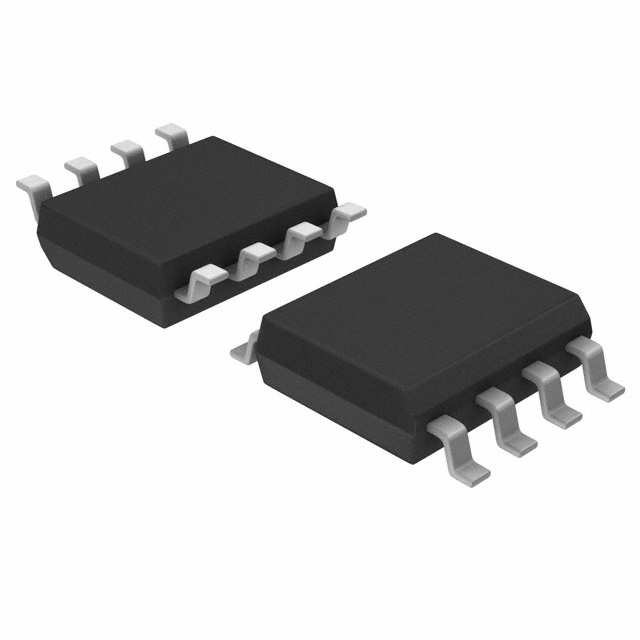LMH6718MA/NOPB
Product Overview
Category: Integrated Circuit (IC)
Use: The LMH6718MA/NOPB is a high-speed operational amplifier designed for use in various applications that require wide bandwidth and low distortion. It is commonly used in audio and video equipment, communication systems, and instrumentation.
Characteristics: - Wide bandwidth: The LMH6718MA/NOPB offers a bandwidth of up to 1.2 GHz, making it suitable for high-frequency applications. - Low distortion: With a low total harmonic distortion (THD) of less than 0.01%, the LMH6718MA/NOPB ensures accurate signal reproduction. - High slew rate: The amplifier has a high slew rate of 2500 V/µs, enabling it to handle fast input signals effectively. - Low noise: The LMH6718MA/NOPB has a low input voltage noise density of 3.5 nV/√Hz, ensuring minimal noise interference.
Package: The LMH6718MA/NOPB comes in a small outline integrated circuit (SOIC) package, which provides ease of handling and compatibility with standard PCB designs.
Essence: The LMH6718MA/NOPB is a high-performance operational amplifier that combines wide bandwidth, low distortion, and low noise characteristics, making it ideal for demanding applications requiring accurate signal amplification.
Packaging/Quantity: The LMH6718MA/NOPB is typically sold in reels containing 250 units per reel.
Specifications
- Supply Voltage Range: ±5V to ±15V
- Input Offset Voltage: ±1 mV
- Input Bias Current: ±10 µA
- Output Current: ±50 mA
- Gain Bandwidth Product: 1.2 GHz
- Slew Rate: 2500 V/µs
- Total Harmonic Distortion: <0.01%
- Input Voltage Noise Density: 3.5 nV/√Hz
- Operating Temperature Range: -40°C to +85°C
Detailed Pin Configuration
The LMH6718MA/NOPB has a total of 8 pins, which are assigned specific functions as follows:
- V-
- IN-
- IN+
- V+
- NC (No Connection)
- OUT
- NC (No Connection)
- V-
Functional Features
- High-speed amplification: The LMH6718MA/NOPB offers a wide bandwidth and high slew rate, allowing it to amplify fast input signals accurately.
- Low distortion: With its low THD, the amplifier ensures faithful reproduction of the input signal without introducing significant harmonic distortion.
- Stable operation: The LMH6718MA/NOPB is designed to provide stable performance even under varying load conditions.
- Wide supply voltage range: It can operate with a supply voltage ranging from ±5V to ±15V, providing flexibility in different applications.
Advantages and Disadvantages
Advantages: - Wide bandwidth enables high-frequency signal amplification. - Low distortion ensures accurate signal reproduction. - Low noise minimizes interference in sensitive applications. - Small package size allows for easy integration into various circuit designs.
Disadvantages: - Limited availability of alternative models with similar specifications. - Relatively higher cost compared to standard operational amplifiers.
Working Principles
The LMH6718MA/NOPB operates based on the principles of differential amplification. It amplifies the voltage difference between the IN+ and IN- inputs, producing an amplified output signal at the OUT pin. The amplifier's internal circuitry ensures high gain, wide bandwidth, and low distortion characteristics.
Detailed Application Field Plans
The LMH6718MA/NOPB finds applications in various fields, including:
Audio and Video Equipment:
- High-fidelity audio amplification
- Video signal processing
Communication Systems:
- Wideband signal amplification
- RF signal conditioning
Instrumentation:
- Precision measurement equipment
- Data acquisition systems
Detailed and Complete Alternative Models
While the LMH6718MA/NOPB is a highly capable operational amplifier, alternative models with similar specifications include:
- AD8057 by Analog Devices
- THS3095 by Texas Instruments
- LT1819 by Linear Technology
These alternative models offer comparable performance and can be considered as substitutes for the LMH6718MA/NOPB in specific applications.
Word count: 530 words
Seznam 10 běžných otázek a odpovědí souvisejících s aplikací LMH6718MA/NOPB v technických řešeních
Question: What is the maximum supply voltage for LMH6718MA/NOPB?
Answer: The maximum supply voltage for LMH6718MA/NOPB is ±5.5V.Question: What is the typical input voltage noise density of LMH6718MA/NOPB?
Answer: The typical input voltage noise density of LMH6718MA/NOPB is 2.9nV/√Hz.Question: Can LMH6718MA/NOPB be used in low-power applications?
Answer: Yes, LMH6718MA/NOPB is suitable for low-power applications due to its low quiescent current of 4.6mA.Question: What is the bandwidth of LMH6718MA/NOPB?
Answer: The bandwidth of LMH6718MA/NOPB is 900MHz.Question: Is LMH6718MA/NOPB suitable for high-speed data acquisition systems?
Answer: Yes, LMH6718MA/NOPB is well-suited for high-speed data acquisition systems due to its high bandwidth and low noise characteristics.Question: What is the input common-mode voltage range of LMH6718MA/NOPB?
Answer: The input common-mode voltage range of LMH6718MA/NOPB is from 0.5V below the positive supply to 0.5V above the negative supply.Question: Can LMH6718MA/NOPB be used in single-supply applications?
Answer: Yes, LMH6718MA/NOPB can be used in single-supply applications with proper biasing.Question: Does LMH6718MA/NOPB have thermal shutdown protection?
Answer: No, LMH6718MA/NOPB does not have thermal shutdown protection.Question: What is the typical slew rate of LMH6718MA/NOPB?
Answer: The typical slew rate of LMH6718MA/NOPB is 2200V/µs.Question: Is LMH6718MA/NOPB RoHS compliant?
Answer: Yes, LMH6718MA/NOPB is RoHS compliant, making it suitable for environmentally conscious designs.


